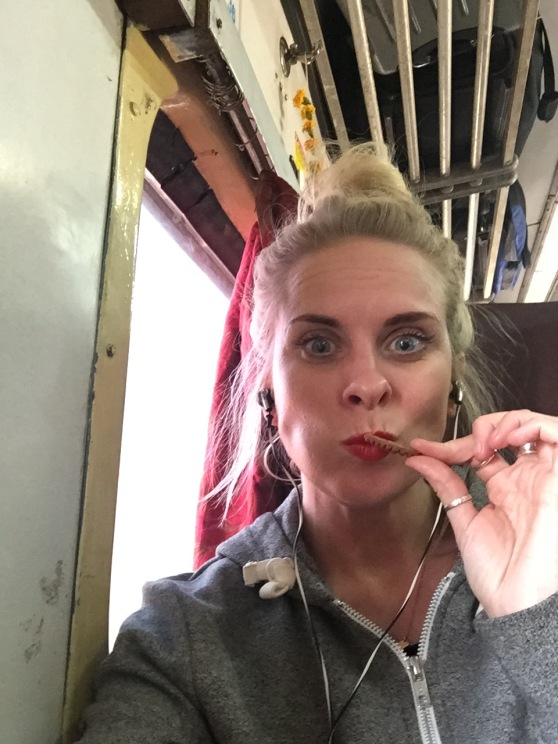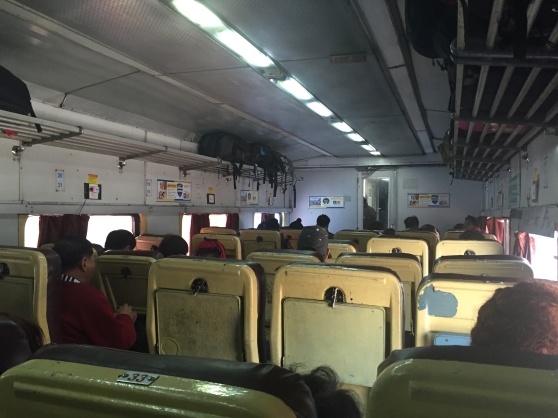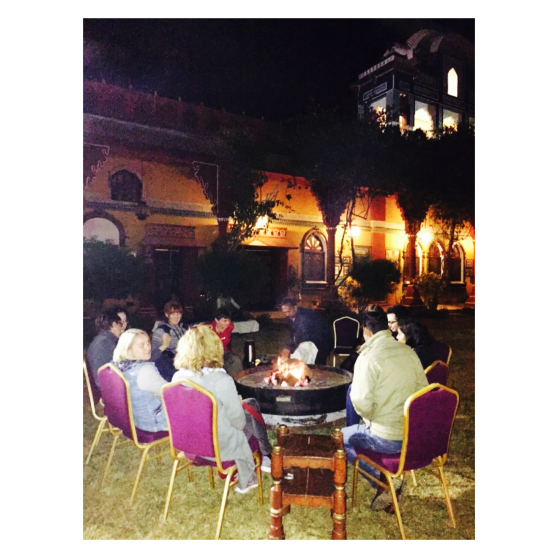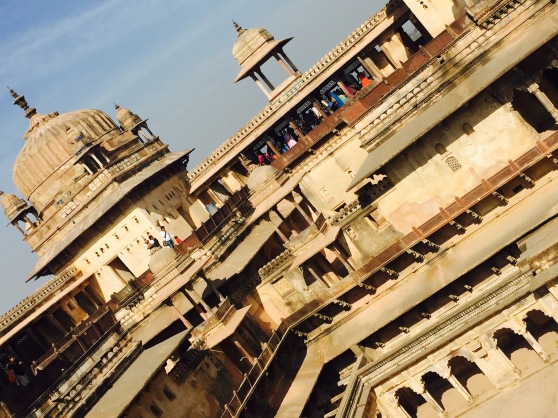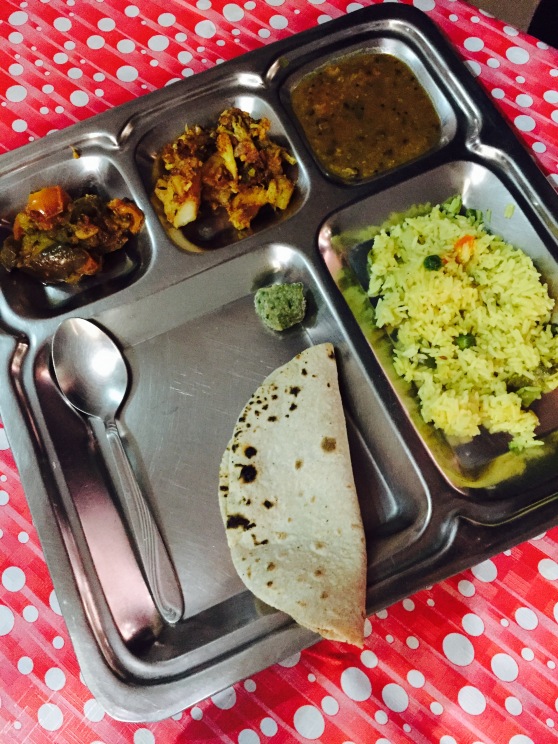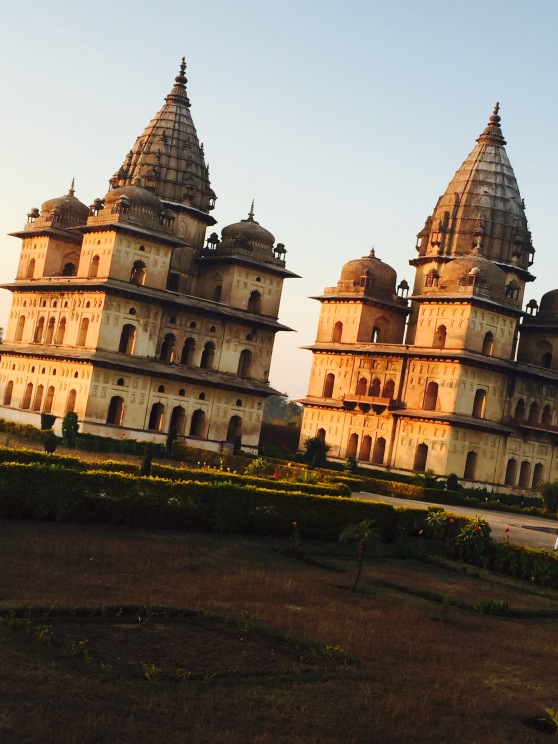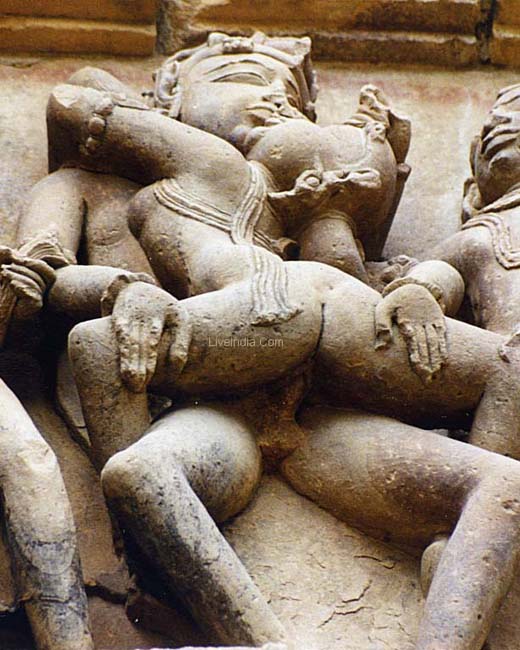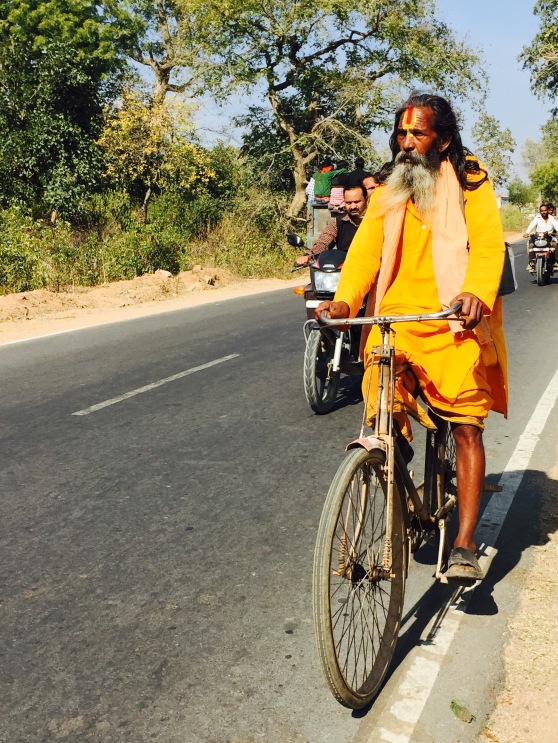We were given a bit of a lie in before our trip to Orchha, up at 8am for a train at 10am! Treat! The journey was only about 4 hours and the train was fairly decent but not quite as nice as the one from the previous day. I had no window, so dozed and ate Oreos until we arrived.
On arrival, it was a little bit of a drive to where we were staying and we arrived in the centre of the small town that is Orchha, to watch the sun as it set over the myriad of temples that adorn the town and the river that runs through it. Swarms of local people trundled over the narrow bridge over the river to attend the evening ceremony in the local Hindu temple.
Orchha is comparatively unknown, compared to majority of key historical sites in India – this is a good thing. It has only a couple of hotels and yet is steeped in history, culture and architecture. It is situated on the banks of the River Betwa, founded in 1531 AD by Rudra Pratap Singh, a Rajput ruler and was the capital of the state. In 1783 Maharaja Vikramjit moved the capital to Tikamgarh and since then, Orchha has kind of fallen in to decay and largely off the grid.
The BBC says it best: Orchha, a tiny town in the central Indian state of Madhya Pradesh, takes you completely by surprise with its medieval ambience. Instead of the drab concrete houses, dusty lanes and untidy shops usually found in rural India, forts, palaces and temples jostle with each other in the bustling town square. This is a place wrapped in legends of feudal chivalry and romance, one that packs more history into every square metre than many better-known places, including Agra and Udaipur. The nearby destination of Khajuraho, famous for its erotic sculptures, usually overshadows Orchha. Only those in-the-know make the trip to this town caught in a time warp where some of the country’s best-preserved Bundelkhandi (a medieval dynasty of central India) architecture and murals can be found.

On arrival, we went for a guided walk around the town to get our bearings and then back to our hotel for a communal bonfire and dinner among the group, which was a really nice opportunity to get to know each other a bit better – and have some booze! As we sat around the bonfire, some local musicians played traditional music and fairy lights lit up the manicured gardens. The hotel itself was great, off the beaten track, quiet, low rise, traditional, open air walkways and lobbies. A stark contrast to the cities we frequented in the week prior. We stayed in little individual cottages with views of the river which were simple and spacious but cold. They did have hot water though, which is always a blessing. What I didn’t like was the man sized hole in my bathroom wall, which was there for god only knows what reason and made me feel quite unsafe at night.
The food at the hotel was delicious and the group were friendly enough by now to begin to share, which was perfect as I like to make all meals in to tapas wherever physically possible, to try multiple things. The aubergine dish was particularly delicious, as was their butter chicken.
The next morning we visited one of the many palaces, which had beautiful blended architecture from Muslim and Hindu culture. I can’t find any specific information on it, because there were forts and palaces galore in Orchha and Im struggling to identify specifics. But the BBC came up trumps again in its description of the town as a whole and it’s various buildings :
The bustling Orchha Fort complex, home to several palaces and monuments, was established by King Rudrapratap Singh in 1501. Orchha was an ideal place to build a capital as the town is sheltered by thick forest, which is probably the reason that these age-old monuments still exist in excellent condition, despite there being no major preservation efforts.
Over the years, several generations of kings and their queens lived in this complex, with a vast retinue of officials, servants, horses and elephants. The entrance gate takes you to a large courtyard from which you enter the Raja Mahal (King’s Palace). Inside the royal chambers, you can see intricate murals of gods, mythological creatures, humans and animals, depicting religious and social themes. The upstairs rooms still have remnants of mirrors in the ceilings and walls; take a minute to imagine the effect when dancing girls swirled around.
Just a short walk away is Jehangir Mahal, a palace built for the Mughal emperor Jehangir’s one-night visit to Orchha in the 17th Century – such was the obsequious flattery shown towards the emperor of India by the local rulers. This four-storey architectural masterpiece is a mix of Muslim and Rajput architecture and has countless rooms with arched entrances, balconies and latticed windows that frame miniature painting-like views of the monument-studded riverbank outside. A steep climb to the top floor via narrow stairways is worth it for the rewarding views over the town. Exit from what is now the back (but was originally the main entrance with an impressive carved gate), past the royal baths to the small abode of the courtesan Rai Parveen, set in a garden designed in the classic Mughal style. Here you can see a life-size portrait of the lady, her sharp features etched out in profile, a transparent gown showing the curves of her body. So famous was this courtesan that Jehangir’s father Emperor Akbar (1556 to 1605) forced her to move to his court in Agra. Parveen, however, composed a couplet for the emperor asking him why he should want to enjoy a meal that was already tasted, and earned her release to return home.
Just outside the fort entrance, looming over the skyline on a high stone platform, is the Chaturbhuj Temple, an imposing structure with stark interiors as no deity was ever worshipped inside. The god Rama, for whom the temple was built, chose instead to reside in a part of the Raja Mahal, appearing to the queen in a dream where he refused to move to his grand, newly built accommodation. Thus a section of the palace was converted into the Ram Raja Temple, which continues to be a lively and bustling venue packed with worshippers who come to pay respects to “King Ram” who rules the town. A 10-minute auto-rickshaw ride from Chaturbhuj is the smaller Laxmi Narayan Temple, which is a unique mix of temple and fort architecture – one curious feature being the canon slots on its roof. There is no statue of the deity here since the last one was stolen some decades ago, but you can see barn owls flying around, which are coincidentally the mount of Laxmi, the goddess of wealth.
In the afternoon we attended a cookery lesson in a local home, which I found disappointing because it was purely instruction rather than participation, but the lady was very informative with great English; and best of all, we got to eat everything afterwards. Nothing she cooked was particularly difficult, so they will be easily replicated at home and recipes were provided. The cooking lady had a little shop in her house and the group excitedly bought up spices and cooking utensils etc. I bought some black cardamom, as I wasn’t sure I bought enough in Mumbai (I did) and a rather sturdy pestle and mortar (which I already have, but I like theirs).
We were then taken to a carpet factory and a paper factory to see how the different processes are carried out. The hard sell in the carpet factory made me quite uncomfortable, but fortunately one of our group actually wanted one, so the heat and pressure was taken off the rest of us. The paper factory was also sold to us as a place where women worked – as a positive attribute – and seeing so few women in employment, the majority us were keen to attend. It was however quite disappointing, as the women were doing all the backbreaking labour, while the men cut paper and worked in the gift shop. It seemed as though the place was run by men – not what we had anticipated – and women were exploited for the hardest manual labour.
At dusk, a few of us went to some local temples – Chhatris – to watch the sunset and view the vultures which come to roost there. I was expecting them to be a little bit closer than they were, like they were in Iquitos, Peru, literally at your feet scavenging around – but they were up high on the roofs of the temples and occasionally flying overhead, Still, impressive birds.
In the evening we went to the evening Hindu prayer ceremony in the local temple; this was quite the spectacle. You are unable to take pictures or videos so sadly I cannot convey the noise and atmosphere as succinctly as I would like, but intense, devoted and chaotic would probably sum things up quite nicely. The ceremony is in a big open, but walled courtyard. The Hindu priest is at the front – dolled up in their finery, whereby they receive gifts and give a blessing with holy water to each person as they come up. There are rows and rows of people in the ‘quick queue’ to get their blessing and give their offerings before the others, but basically are in metal cattle holding pens. Some of these people walk for miles to attend this ceremony. Men, women, children, babies, families, young and old. Some Hindu guys are in traditional dress with the full face paint. Everyone is barefoot or in socks, as no shoes are allowed inside – nor any leather, at all. Someone shouts out prayers over a microphone in a slightly manic way, and all the audience shout back. Some of the more local/frequent male attenders group together and sing hymns or prayers in a low tone perpetually throughout. Some people prostrate themselves upon the floor completely, like I saw in Tibet. People wave incense. There are televisions, broadcasting what is happening at the front. Hoards of people go up to give their offerings. Hoards of people come back. Most of them stare at the strange white people in their temple, sometimes, this may last several minutes and gets quite uncomfortable – but we are in their environment, their temple, and it is to be expected.
We had a ‘day off’ for our final day in Orchha. Some of the group went to a temple a 3 hour drive away which depicts carvings from the Karma Sutra called Khajuraho. I didn’t know much about it, but some of the group had specifically wanted to visit there. I had to google the info as I wasn’t aware of the history:
A UNESCO world heritage site in central India, Khajuraho is a famous tourist and archaeological site known for its sculptured temples dedicated to Shiva, Vishnu, and Jain patriarchs. Khajuraho was one of the capitals of the Chandela kings, who from the 9th to the 11th century CE developed a large realm, which at its height included almost all of what is now Madhya Pradesh state. Khajuraho extended over 21 sq. km and contained about 85 temples built by multiple rulers from about 950 to 1050. In the late 11th century the Chandela, in a period of chaos and decline, moved to hill forts elsewhere. Khajuraho continued its religious importance until the 14th century but was afterwards largely forgotten; its remoteness probably saved it from the desecration that Muslim conquerors generally inflicted on Hindu monuments. In 1838 a British army captain, TS Burt, employed by the Asiatic Society in Calcutta, came upon information that led him to the rediscovery of the complex of temples in the jungle in Khajuraho.
Of the 85 original temples-most constructed of hard river sandstone-about 20 are still reasonably well preserved. Both internally and externally the temples are richly carved with excellent sculptures that are frequently sensual and, at times, sexually explicit.
As we were getting the sleeper train that evening for 10 hours and then camping in the Ganges, I thought a 6 hour car ride would be a bit too much, so I stayed behind with some of the others and just explored Orchha by foot and bought some local art. They are also quite free with non prescription drugs in their pharmacies too – great for aiding sleep on sleeper trains and camping!
Even after the disastrous prison massage of Kerala, I decided a massage at the hotel might be a good idea in the afternoon before we left for the overnight train. The other women in the group were doing it so I thought – why not! Again, in a brightly lit room, I was made to strip in front of a stranger. This time only down to knickers. She was markedly improved from the random swooshing masseuse in Kerala, but didn’t focus on any of my tension points, didn’t ask or even work out if I had any knots which needed attention, spent at least 5 minutes massaging my boobs – in isolation (very, very odd), short changed me by 15 minutes (which I was glad of) and then demanded a tip at the end. I really must learn my lesson.
Overall, Orchha was a lovely quiet, sleepy town, with great architecture, deeply religious, very few tourists – making it feel a little bit off the typical backpacker trail, and with much to see. After days of large cities and big sites, this was a welcomed and relaxing stop to recharge for the next location.

